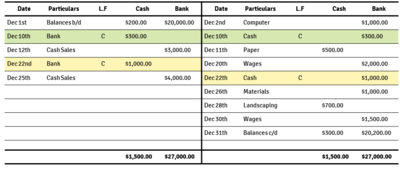Contra entry
Contra entry It is the record which is entered in purpose of reversing or offsetting corresponding record placed on another side of the same account in Cash Book. Purpose of Contra Entry is to reduce the balance of an entry on the other side of account. It does not affect Net Cash Balance. Contra Entry is also known as “Against” or “Opposite” entries. For example- credit entry of $200 was made on the account (amount added), on the other side of the account (in debit) $200 entry (amount taken away) is the Contra Entry. Because of Contra Entry in the same amount as credit- account is balanced.
Letter “C” is used as a symbol of the Contra Entry in Ledger Folio Column (after ledger name). Contra Entry is essential part of both Double- Column as well as Three- Column Cash Books.
Examples of Contra Entry transactions
Contra Entry is used when:
- Cash is deposited into bank:
Debit: Bank A, Credit: Cash
In this case Dt is made in Bank account, but the Ct Entry is made in Cash on the account.
- Cash is withdrawn from the bank,
Debit: Cash, Credit: Bank B
In this case Dt is made in Cash on the account, but the Ct Entry is made in Bank Account.
- Cash is transferred between two accounts,
Debit: Cash, Credit: Cash
In this case Dt is made in Cash on the account that transfer goes from, but the Ct Entry is made in Cash on the account transfer goes to.
- Fund is transferred between two banks (Bank B to Bank A):
Debit: Bank A, Credit: Bank B
In this case Dt is made in Bank account that transfer goes from, but the Ct Entry is made in Bank account transfer goes to.
Contra Entry in double column cash book
Below transactions are about to be entered into double- column cash book (balanced as at 31st Dec 2018):
| Date | Particulars | Amount |
|---|---|---|
| Dec 1st | Bank Balance b/d | $20,000.00 |
| Dec 1st | Balance of cash | $200.00 |
| Dec 2nd | Paid by check for Computer | $1,000.00 |
| Dec 10th | Withdrew from bank for office use | $300.00 |
| Dec 11th | Paid for paper- cash | $500.00 |
| Dec 12th | Banked cash sales | $3,000.00 |
| Dec 20th | Paid wages by transfer | $2,000.00 |
| Dec 22nd | Withdrew from bank for office use | $1,000.00 |
| Dec 25th | Banked cash sales | $4,000.00 |
| Dec 26th | Paid by check for materials | $1,000.00 |
| Dec 28th | Paid by cash for landscaping services | $700.00 |
| Dec 30th | Paid wages by transfer | $1,500.00 |
Double column cash book
| Date | Particulars | L.F | Cash | Bank | Date | Particulars | L.F | Cash | Bank |
|---|---|---|---|---|---|---|---|---|---|
| Dec 1st | Balances b/d | $200.00 | $20,000.00 | Dec 2nd | Computer | $1,000.00 | |||
| Dec 10th | Bank | C | $300.00 | Dec 10th | Cash | C | $300.00 | ||
| Dec 12th | Cash Sales | $3,000.00 | Dec 11th | Paper | $500.00 | ||||
| Dec 22nd | Bank | C | $1,000.00 | Dec 20th | Wages | $2,000.00 | |||
| Dec 25th | Cash Sales | $4,000.00 | Dec 22th | Cash | C | $1,000.00 | |||
| Dec 26th | Materials | $1,000.00 | |||||||
| Dec 28th | Landscaping | $700.00 | |||||||
| Dec 30th | Wages | $1,500.00 | |||||||
| Dec 31th | Balances c/d | $300.00 | $20,200.00 | ||||||
| $1,500.00 | $27,000.00 | $1,500.00 | $27,000.00 |
Contra entries are the transactions done on Dec 10th and Dec 22th (with "C" in L.F. Column).
References
- Banerjee, A. (2005). Financial Accounting a Managerial Emphasis. Second Edition.
- Erkes, H. (1921). The Teller's Brotter, "Bankers' Magazine (1896-1943); Cambridge Tom 102, No/edition 5, (May 1921): 760."
- Hoyle, K., & Whitehead, G. (1979). Business Statistics and Accounting Made Simple
- Kotas, R., & Conlan, M. (1997). Hospitality Accounting Fifth Edition
- Nhleko, Z. (2010). IFC’s contribution to the 57th ISI Session, Durban, 2009, "IFC Bulletin No 33."
- Sangster, A. (2016). The Genesis of Double Entry Bookkeeping, "The Accounting Review: January 2016, Vol. 91, No. 1, pp. 299-315"
- Tulisan, P. C. (2015). Tulisan's Quick Revision For Financial Accounting (For ICWA Intermediate: Paper 5)
Author: Patryk Wykręt
